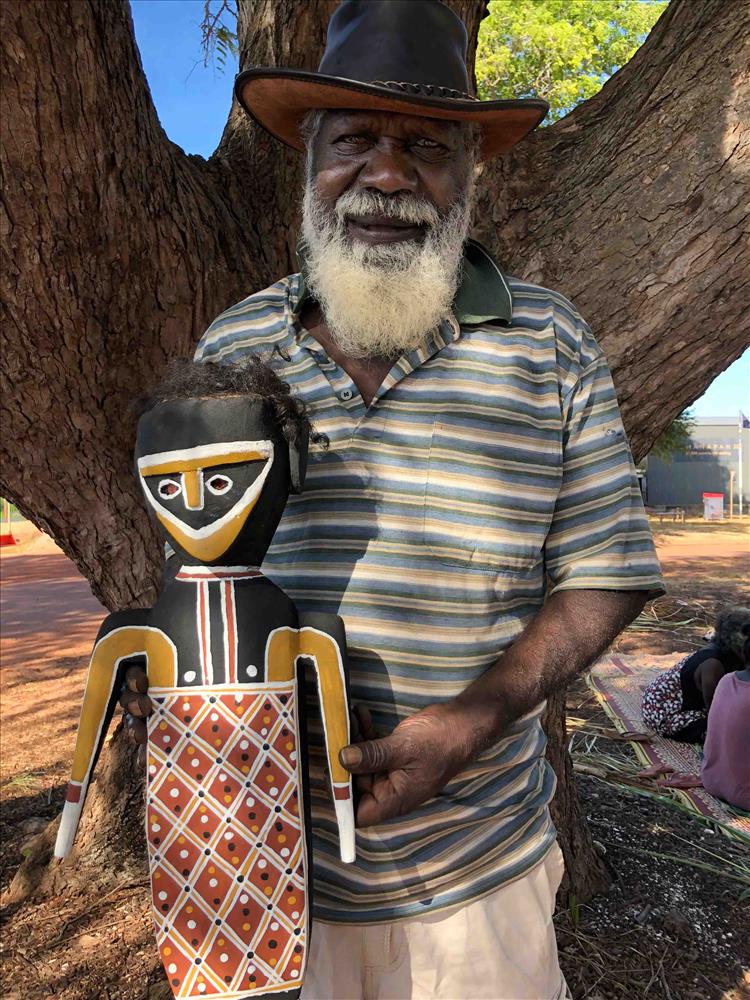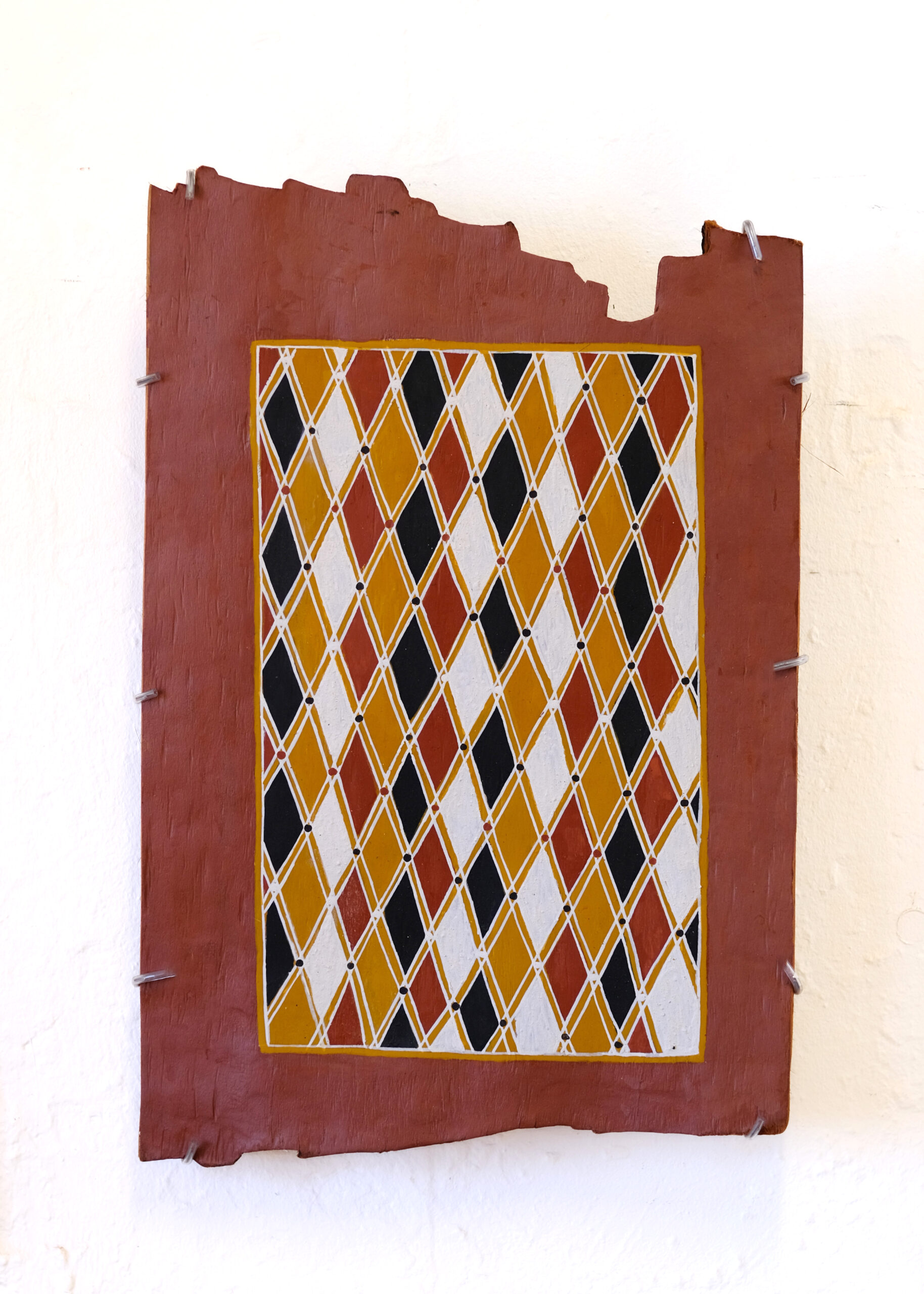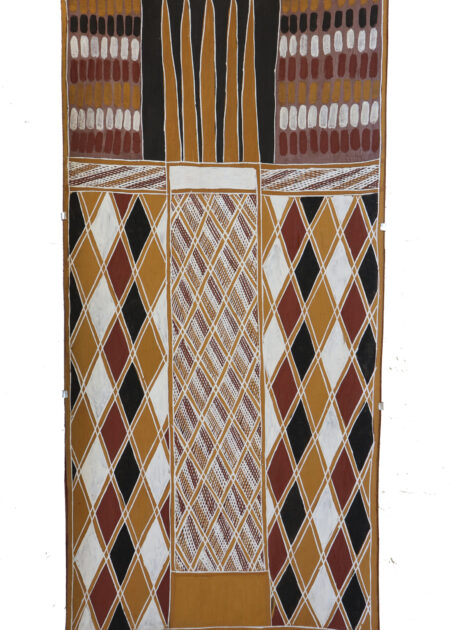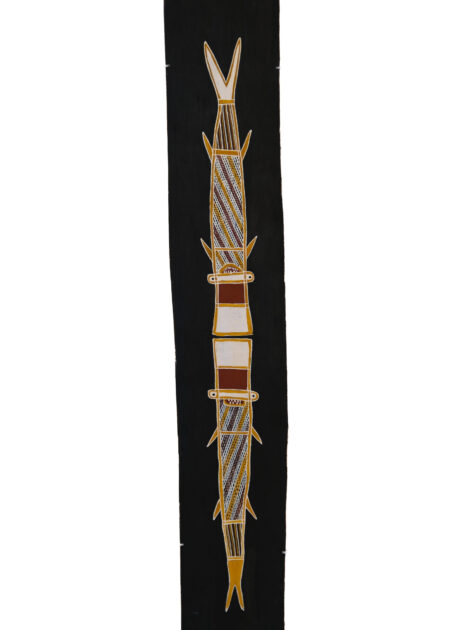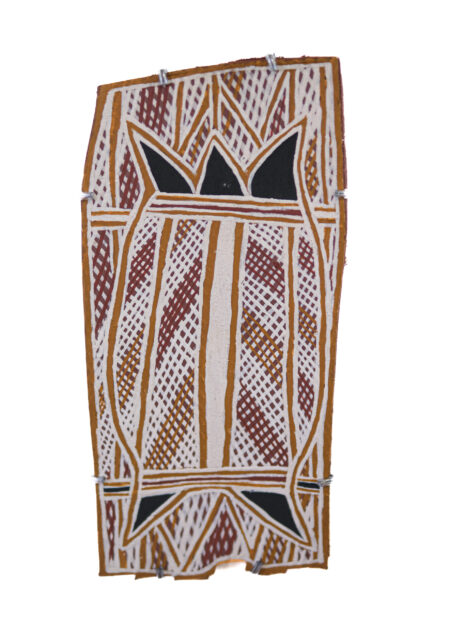Description
“This is my djalkiri, my foundation. We [Gupapuyŋu Ḏaygurrgurr] share this. It is our backbone, since forever.” – Joe Dhamanydji
This design, belonging to the Gupapuyŋu Ḏaygurrgurr clan of the Yirritja moiety, shows their primary clan design Guku Galaniyin’ (Native Bee and Honey) in the full splendour of its ceremonial expression. The artist, inspired by researching early historic collections from the 1920’s to 1950’s, has returned to the orthodox galaŋarr form his forefathers bestowed upon him.
Galaŋarr is a Yirritja word used by dhuwala-mirri language speakers to indicate the form used when painted on bodies during ceremony. This includes the main rumbal (body) painted on the chest, yaŋara’ (legs), and waṉa (arms) that are painted over the shoulders. During the high law ceremony of ŋärra, these layers of design are added progressively throughout the ceremony to make the final complete form, which is seen in this painting.
Sometimes the first layer, the rumbal or guḻun-mirri (chest design) is referred to as tjiŋlit-mirri galaŋarr, coming from the English word ‘singlet’ (lit. singlet-shaped body paint design). Next the yaŋura’ is added, before the final layer of waṉa are included. The waṉa ‘arms’ are said to represent those that hang from the djaḻi (armbands) of Gupapuyŋu people as the leave the restricted Ŋärra ceremony grounds for the final stage of the public buku-lup cleansing.
The artists brother, George Milaypuma, gives the story of Guku Galanyin’.
Guku ŋayi waṉḏin, ŋunhi ŋayi waṉḏin wuymirrilil. Wuymirri ŋayi mam’thurr. Waŋgany guku ŋayi waṉḏin. Waŋganydja ŋayi wuymirrilil waṉḏin. Mam’thurr ŋayi. Yanapi ŋayi wäŋa nhäŋal, ŋanydja ŋunhi ŋayi wuymirri nhäŋal, ŋayi mam’thurr. Waŋganydja baladhi guku. Bala wuymirriy bilyurrnha ga ŋanyany guykthurr buku ŋanya guykthurr wuymirriy gukun.
Honey bee went travelling, and went and found a whale. He stamped his imprint onto the whale. One honey bee went [that way]. One went and found a whale. It stamped [its diamond pattern onto the whale]. He thought it was land, but it was a whale that he saw, that he stamped [his design] onto. That’s where one honey bee went. Then the whale turned and spurted a spout of spray onto the face of that honey bee.
Ga bulu waŋgany ŋayi guku waṉḏin bala westlil, bala bäpurru ŋayi nhäŋal Buṉuŋgu ga Warray’ŋuwal. Ŋayi waṉḏin waŋganydja guku. Ŋunhi ŋayi baladhi buṯthurr guku Buṉuŋgu ga Warray’ŋuwal ŋayi waṉḏin ga ŋayi dharpuŋal ḻanapu. Gukun djäma ŋayi ḻanapu’ŋur. Mam’thurr ŋayi ga dharpuŋal ḻanapu.
Another honey bee travelled west, and saw the Buṉuŋgu and the Warray’ŋu clans. One honey bee travelled there. The one that flew to the Buṉuŋgu and Warray’ŋu lands made a hive in the cypress pine. The bee made honey in the cypress pine. He made his imprint there, and put a honey in the cypress tree.
Ga waŋgany ŋayi guku buṯthurr bala dhimurru’lil. Ŋunhi ŋayi buṯthurr bala eastlil munhagu. Ŋunhi bala buṯthurr bala eastlil munhagu, ga nhanŋu djarraw’yurr ga bäyŋu roŋiyina räli Djiliwirrilil. Ga dhuwal ŋunhi dhäwu gukupuy. Dhuwal ŋunhi dhäwu gukupuy ŋäṉitj, nhaltjarr walal butthurr, wäŋalil ga wäŋalil. Märrma’ roŋiyin. Waŋgany roŋiyiny räli Djiliwirrilil roŋiyiny ŋulaŋur wuymirriwalaŋaŋur roŋiyiny ŋayi. Räli djiliwirrilil ŋayi roŋiyin. Ga waŋgany ŋulaŋur ŋayi roŋiyin guku Buṉuŋguwal ga Warray’ŋuwal, ŋayi roŋiyindhi räli. Räli Djiliwirrilil ŋayi roŋiyiny. Ga waŋgany ŋunhi eastlil ŋayi buṯthurr bala eastlil guku ŋäṉitj – ga bäyŋu ŋayi roŋiyinha. Ga dhiyal ŋunhi dhäwu dhawar’yun guku ŋäṉitjpuy. Gukupuy dhäwu dhuwal ga ŋorra. Guku Djiliwirripuy dhuwal ga dhäwu ŋorra. Djiliwirriw ŋäṉitj.
And one honey bee flew east. And it flew east at night. It flew there to the east at night, and at daybreak it didn’t come back to Djiliwirri. And that is the honey bee story. That’s the story of the honey bees, ŋäṉitj, where they flew, from place to place. Two came back. One came back this way to Djiliwirri, from there, from finding the whale, it came back. It came back to Djiliwirri. And one came back this way from Buṉuŋgu and Warray’ŋu country. It came back this way to Djiliwirri. And one honey bee that flew east – it didn’t come back. And here the honey story ends. This is the honey story. This is the honey story of Djiliwirri. Djiliwirri honey.
George Milaypuma goes onto explain that the Gupapuyŋu honey design is, besides during ŋärra, this design is also painted onto the chests of Gupapuyŋu boys at their Dhapi ceremony (circumcision). It was traditionally painted onto the body of the deceased during Bäpurru (mortuary rites). While this still occurs, especially for very senior Gupapuyŋu, the design will more frequently be painted on the coffin of the deceased. This serves to identify the deceased as Gupapuyŋu during the journey home to the deep ancestral waters of the billabongs at Djiliwirri.
All barks from Milingimbi Art and Culture come Strapped and ready to hang

